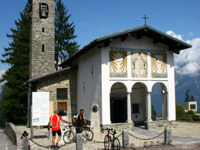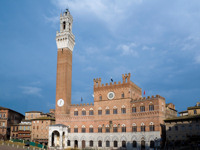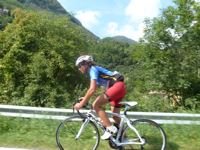Cycling in Italy: Rewarding routes and stunning scenery
Having recently completed a cycling tour of Italy, Matthew Ogborn has plenty of advice for those planning to take a two-wheeled trip around the diverse and scenic country.
 Follow in the tracks of Giro d'Italia riders
Follow in the tracks of Giro d'Italia ridersWTG / Matthew Ogborn
After being given the opportunity to report on the famous Tour de France cycling race for the last five years, I decided to convert my enthusiasm for the sport into a cycling trip to neighbouring Italy, where the locals' love of ciclismo rivals that of the French.
Italy is full of remarkable cycling routes that take advantage of the staggering scenery from the mountains of the north down to the cauldron of the southern 'boot'. This provides the backdrop to the famous Giro d’Italia road race held every May and June.
Cycling in northern Italy
For this trip, my partner and I borrowed bikes from a friend who lives in a small town near the striking Lake Como, bordering the Alps. Often regarded as one of the jewels of the Italian tourist circuit, the terrain surrounding the lake also provides a great selection of routes for all levels.
Winding our way north from the cute town of Menaggio, which sits halfway up the western side of the lake, we are treated to broad, expansive roads and sightings of local wildlife.
Heading back down the eastern side of the lake, you reach the small town of Varenna, where you can take a quick dip in the tempting lido to cool off from your exertions. You then have the option of continuing down to Lecco (if you're staying overnight), or catching one of several ferries that cross the water back to Menaggio or Bellagio.
 Climb to the charming Madonna del Ghisallo church
Climb to the charming Madonna del Ghisallo churchWTG / Matthew Ogborn
We head for Bellagio, a favourite haunt of rich Americans, with its glitzy shops and wide-ranging restaurants. And we are thankful for this rejuvenating pit stop, as the steep and gruelling climb up to the peak of Madonna del Ghisallo is soon on the agenda.
It may take an hour or so, but the sweeping view makes it all worthwhile. The small church is a moving shrine to Italian cyclists past and present, along with the cream of foreign riders. Those that have lost their lives on the road are singled out with photos, alongside the old bikes of heroes such as Giro d’Italia winners Fausto Coppi and Gino Bartali.
You can ride in northern Italy during the summer as we did (and many Italians also regularly do), but the heat of the central and southern regions could potentially ruin the trip, so it pays to check temperatures in advance.
Along with a visit by car to the cycling mecca of Novi Ligure, south of Milan, which houses an impressive museum, our brief trip offers a brilliant taste of the generous hospitality, sensational scenery and classy routes that mark out Italy as a cyclist’s dream.
Varied routes throughout Italy
Overall, Italy is overflowing with routes for advanced, intermediate and beginner cyclists that will leave you breathless with admiration as well as exhaustion.
My advice is to avoid busier 'A roads', while looking out for notoriously erratic Italian drivers, who have a propensity to straddle lanes and talk animatedly instead of driving. Needless to say, helmets and reflectors are a must.
Hardy riders, both female and male, love to replicate the arduous stages undertaken by their professional heroes during the Grand Tours (of which Giro d’Italia is just one) each year, with the fearsome Stelvio Pass, near Bormio in South Tyrol, a big favourite if you want lots of switchbacks.
 Stop off at charming towns or cities, such as Siena
Stop off at charming towns or cities, such as SienaiStockphoto / Thinkstock
Amateur riders should prepare properly for this beast of pass and other hilly routes; otherwise they could pay the price. Plenty of fluids, energy snacks and a realistic time frame on a day when the snow, wind and rain is absent, will maximise your pleasure.
Alternatively, if you’re looking for gentler routes that are not as tough on your body and mind, then head to either coast, with the eastern side of Italy more sedate than the west.
Tuscany is a perennial favourite and, probably, your best bet if you want to ease into your Italian cycling. The scenery is beautiful and the routes are varied enough to make a week fly by, plus it has the added bonus of charming cities Florence and Siena.
Let us not forget that there are also some cracking mountain bike routes, besides the coveted road routes, that dot the jaw-dropping landscape. The steeper rugged areas of the Alps and wooded Apennines, which stretch down the spine of the country, are perfect for off-roaders looking for an intoxicating mixture of greenery and gradient.
It pays to plan ahead
Overall good planning is vital. Getting there by air with kit can be a challenge, but British Airways is the best of the bunch, and lets you check your bike for free as part of your hold allowance.
Trains are a tad more difficult if you do not have a fold-down bike. The Artesia sleeper trains from Paris, Paris-Milan and the Artesia TGV trains and EuroCity trains from Switzerland do not allow bikes unless you take them on as carry-on luggage in a zip-up bike bag.
 Plan ahead for a hassle-free trip
Plan ahead for a hassle-free tripKatie Thomis
Once in Italy, travelling around with a bike is a little easier. You pay an extra fare of €3.50 to €5 to stow your bike in the carriage or luggage van on many local, regional, InterCity & EuroCity trains with the suitable trains indicated by a bike symbol in the timetables. See Trenitalia for details.
Many riders find the easiest option is to drive down from the United Kingdom to Italy in order to avoid the hassle of buses, coaches, planes and trains. It’s worth putting some effort into planning the route and where to stay well in advance. There are plenty of options for bike-friendly accommodation, but the best include Italy Bike Hotels and Responsible Travel.
If you want to hire on arrival: BikeRentalsPlus and That’s Amore can meet your needs.
Best time to go: Autumn and spring.
Best way to get there with bikes: By car.
Best thing to take with you: John Foot’s excellent book on the history of Italian cycling, Pedalare! Pedalare! A History of Italian Cycling (Bloomsbury, 2011).
Do you have any Feedback about this page?
© 2026 Columbus Travel Media Ltd. All rights reserved. No part of this site may be reproduced without our written permission, click here for information on Columbus Content Solutions.









 You know where
You know where